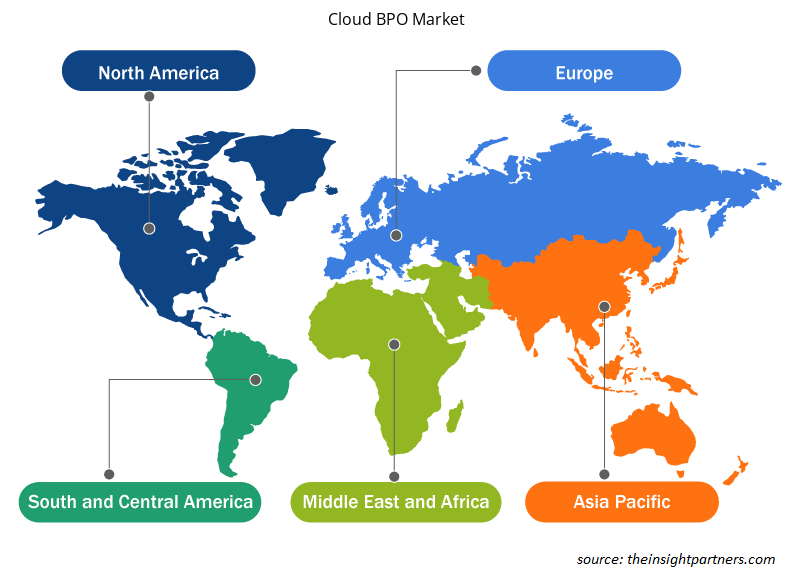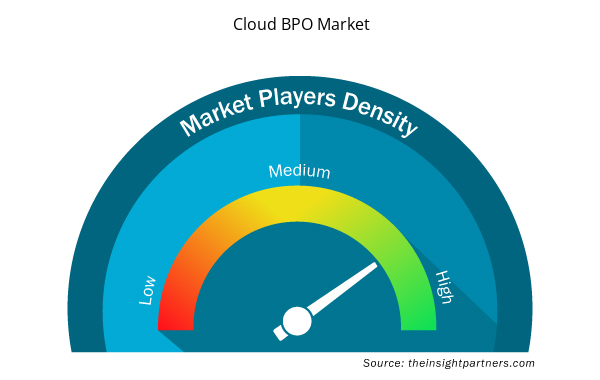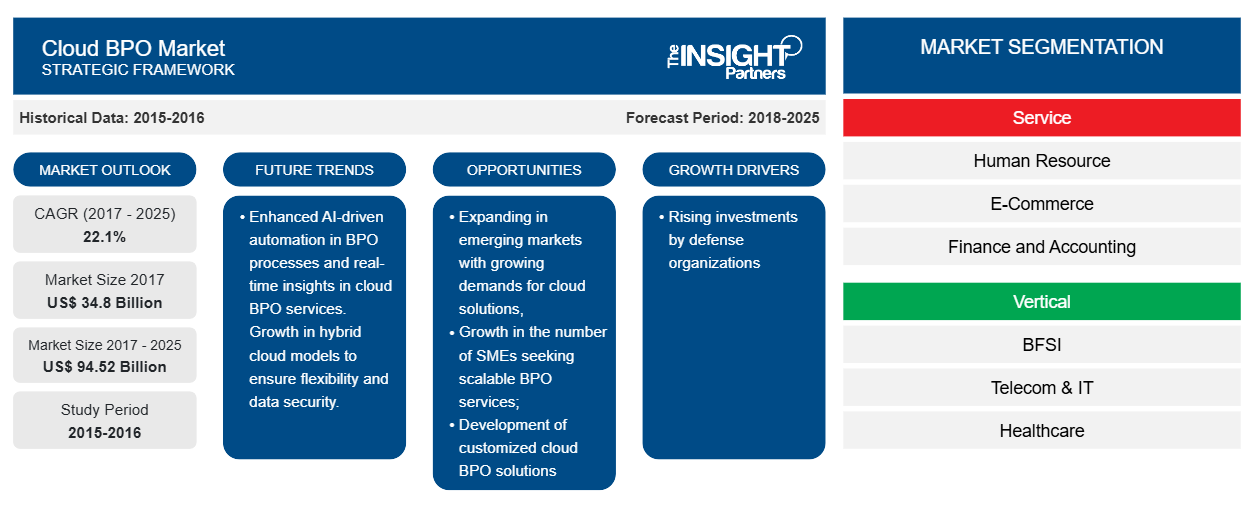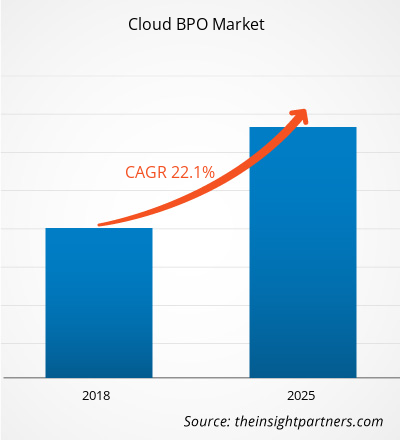من المتوقع أن ينمو سوق خدمات الاستعانة بمصادر خارجية السحابية من 34,801.2 مليون دولار أمريكي في عام 2017 إلى 94,522.7 مليون دولار أمريكي بحلول عام 2025؛ ومن المتوقع أن ينمو بمعدل نمو سنوي مركب نسبته 22.1٪ من عام 2017 إلى عام 2025.
إن انخفاض تكلفة التشغيل والمرونة التي توفرها خدمات الاستعانة بمصادر خارجية عبر السحابة ترجع إلى نمو السوق. وتعتبر ميزة التكلفة التي توفرها خدمات الاستعانة بمصادر خارجية عبر السحابة أحد الأسباب الرئيسية التي تؤثر على اختيار المؤسسات فيما يتعلق بخدمات الاستعانة بمصادر خارجية عبر السحابة التقليدية. فهي تقلل بشكل كبير من تكلفة تكنولوجيا المعلومات للمؤسسة من خلال توفير الدعم والصيانة للبرامج والأجهزة، كما تعمل على ترقية وتحديث وإدارة العمليات بسهولة، مما يؤدي لاحقًا إلى خفض تكلفة الخدمات التجارية.
من ناحية أخرى، تستفيد شركات الاستعانة بمصادر خارجية بشكل كبير من تكامل الحوسبة السحابية. حيث يتمكن مزودو خدمات الاستعانة بمصادر خارجية من الاستفادة من فوائد الحوسبة السحابية من خلال تقليل وقت المعالجة لعمليات الأعمال كثيفة البيانات في المؤسسات، وتقديم سير عمل معالجة البيانات في وقت استجابة مضغوط. كما تستفيد شركات الاستعانة بمصادر خارجية السحابية بشكل كبير من حيث مرونة إضافة وظائف وميزات جديدة إلى أنظمتها وتحقيق متطلبات العملاء المتغيرة بشكل فعال. توفر المنصات السحابية لشركات الاستعانة بمصادر خارجية بديلاً مرنًا من خلال القضاء على ضغوط المنافسة القادمة في السوق. ونظرًا لهذه المزايا التي توفرها خدمات الاستعانة بمصادر خارجية السحابية، تفضل الشركات في جميع الصناعات الاستعانة بمصادر خارجية لعملياتها التجارية لمقدمي خدمات الاستعانة بمصادر خارجية السحابية، مما يؤدي لاحقًا إلى نمو سوق الاستعانة بمصادر خارجية السحابية على مستوى العالم.
قم بتخصيص هذا التقرير ليناسب متطلباتك
ستحصل على تخصيص لأي تقرير - مجانًا - بما في ذلك أجزاء من هذا التقرير، أو تحليل على مستوى الدولة، وحزمة بيانات Excel، بالإضافة إلى الاستفادة من العروض والخصومات الرائعة للشركات الناشئة والجامعات
- احصل على أهم اتجاهات السوق الرئيسية لهذا التقرير.ستتضمن هذه العينة المجانية تحليلاً للبيانات، بدءًا من اتجاهات السوق وحتى التقديرات والتوقعات.
رؤى السوق
سوق خدمات التعهيد الخارجي السحابية
الإلزام بتحسين خدمة العملاء
The customers in today’s highly competitive environment are well aware about their burgeoning power and value as they have encountered with the digital economy and attained access to various services worldwide. This has further raised their expectations with respect to cloud based services as organizations have become more aware about the benefits of Cloud BPO services. The cloud as a core platform has been already been leveraged by the clients as a novel external as well as internal initiative, which has subsequently increased the competition among the BPO service providers, further motivating them to adopt improvised technologies such as cloud based technologies to serve their customers/clients in a better way.
Services -Based Insights
Based on services, the cloud BPO market is segmented into human resource, e-commerce, finance and accounting, customer care, sales & marketing, others. The human resource segment held the largest market share in 2016.
Players operating in the cloud BPO market are mainly focused on the development of advanced and efficient products.
- In 2017, IBM and Dream Payments Expand Payment Services on the Cloud to U.S. Financial Institutions.
- In 2017, CMA CGM Group Signs Strategic Partnership with Infosys to Accelerate Transformation of its Information Systems.
Cloud BPO Market Regional Insights
The regional trends and factors influencing the Cloud BPO Market throughout the forecast period have been thoroughly explained by the analysts at Insight Partners. This section also discusses Cloud BPO Market segments and geography across North America, Europe, Asia Pacific, Middle East and Africa, and South and Central America.

- Get the Regional Specific Data for Cloud BPO Market
Cloud BPO Market Report Scope
| Report Attribute | Details |
|---|---|
| Market size in 2017 | US$ 34.8 Billion |
| Market Size by 2025 | US$ 94.52 Billion |
| Global CAGR (2017 - 2025) | 22.1% |
| Historical Data | 2015-2016 |
| Forecast period | 2018-2025 |
| Segments Covered | By Service
|
| Regions and Countries Covered | North America
|
| Market leaders and key company profiles |
|
Market Players Density: Understanding Its Impact on Business Dynamics
يشهد سوق خدمات الاستعانة بمصادر خارجية عبر السحابة نموًا سريعًا، مدفوعًا بالطلب المتزايد من جانب المستخدم النهائي بسبب عوامل مثل تفضيلات المستهلكين المتطورة والتقدم التكنولوجي والوعي المتزايد بفوائد المنتج. ومع ارتفاع الطلب، تعمل الشركات على توسيع عروضها والابتكار لتلبية احتياجات المستهلكين والاستفادة من الاتجاهات الناشئة، مما يؤدي إلى زيادة نمو السوق.
تشير كثافة اللاعبين في السوق إلى توزيع الشركات أو المؤسسات العاملة في سوق أو صناعة معينة. وهي تشير إلى عدد المنافسين (اللاعبين في السوق) الموجودين في مساحة سوق معينة نسبة إلى حجمها أو قيمتها السوقية الإجمالية.
الشركات الرئيسية العاملة في سوق Cloud BPO هي:
- شركة فيرست سورس سوليوشنز المحدودة
- شركة دبليو ان اس القابضة المحدودة
- انفوسيس المحدودة
- شركة اتش سي ال للتكنولوجيا المحدودة
- شركة جينباكت المحدودة
إخلاء المسؤولية : الشركات المذكورة أعلاه ليست مرتبة بأي ترتيب معين.

- احصل على نظرة عامة على أهم اللاعبين الرئيسيين في سوق Cloud BPO
تم تقسيم سوق BPO السحابي على النحو التالي:
سوق خدمات التعهيد الخارجي السحابية – حسب الخدمات
سوق خدمات التعهيد الخارجي السحابية – حسب القطاع
- الخدمات المالية والمصرفية والتأمين
- الاتصالات وتكنولوجيا المعلومات
- الرعاية الصحية
- السيارات
- تصنيع
- الأطعمة والمشروبات
- الطاقة والقوة
- الالكترونيات الاستهلاكية
- آحرون
سوق خدمات التعهيد الخارجي السحابية – حسب المنطقة الجغرافية
أمريكا الشمالية
- نحن
- كندا
- المكسيك
أوروبا
- فرنسا
- ألمانيا
- إيطاليا
- إسبانيا
- المملكة المتحدة
آسيا والمحيط الهادئ (APAC)
- اليابان
- الصين
- أستراليا
- الهند
الشرق الأوسط وأفريقيا
- المملكة العربية السعودية
- الامارات العربية المتحدة
- جنوب أفريقيا
أمريكا الجنوبية (SAM)
- البرازيل
سوق خدمات التعهيد الخارجي السحابية – نبذة عن الشركة
- شركة آي بي إم
- شركة أوراكل
- ساب اس اي
- إتش بي إي
- مدرك
- إنفوسيس
- أكسنتشر
- تاتا للاستشارات
- نظام سنجارد المالي
- ويبرو
- التحليل التاريخي (سنتان)، السنة الأساسية، التوقعات (7 سنوات) مع معدل النمو السنوي المركب
- تحليل PEST و SWOT
- حجم السوق والقيمة / الحجم - عالميًا وإقليميًا وقطريًا
- الصناعة والمنافسة
- مجموعة بيانات Excel



Report Coverage
Revenue forecast, Company Analysis, Industry landscape, Growth factors, and Trends

Segment Covered
This text is related
to segments covered.

Regional Scope
North America, Europe, Asia Pacific, Middle East & Africa, South & Central America

Country Scope
This text is related
to country scope.
الأسئلة الشائعة
The Human Resource Outsourcing services offered by the Cloud BPOs facilitate the organizations approach the core HRO needs while synergizing business objectives with resource utilization.
Surging demand for Cloud BPO is aligned with the progression in global market for Robotic Process Automation (RPA). The RPA with other digital disruptors comprise of digital labor and advanced software automation has a potential to drive the new generation of Cloud BPOs facilities that offer virtual workforce.
North America region holds the largest market share in the cloud BPO market, owing to rising demand from the public sector, mid-size banking, healthcare sector and financial service organizations. The cloud based outsourcing industry in the region has recently witnessed multiple merger & acquisitions, partnerships and reconstruction which makes the market to grow efficiently in North America.
The List of companies
1. Firstsource Solutions Ltd.
2. WNS (Holdings) Ltd.
3. Infosys Ltd.
4. HCL Technologies Ltd.
5. Genpact Ltd.
6. Capgemini SE
7. CA Inc.
8. Atos SE
9. Tata Consultancy Services Ltd.
10. DXC Technology Company
11. Sungard
12. Accenture PLC
13. ADP LLC
14. IBM Corporation
15. Oracle Corporation
16. SAP SE
17. Xerox Corp.
18. HPE
The Insight Partners performs research in 4 major stages: Data Collection & Secondary Research, Primary Research, Data Analysis and Data Triangulation & Final Review.
- Data Collection and Secondary Research:
As a market research and consulting firm operating from a decade, we have published and advised several client across the globe. First step for any study will start with an assessment of currently available data and insights from existing reports. Further, historical and current market information is collected from Investor Presentations, Annual Reports, SEC Filings, etc., and other information related to company’s performance and market positioning are gathered from Paid Databases (Factiva, Hoovers, and Reuters) and various other publications available in public domain.
Several associations trade associates, technical forums, institutes, societies and organization are accessed to gain technical as well as market related insights through their publications such as research papers, blogs and press releases related to the studies are referred to get cues about the market. Further, white papers, journals, magazines, and other news articles published in last 3 years are scrutinized and analyzed to understand the current market trends.
- Primary Research:
The primarily interview analysis comprise of data obtained from industry participants interview and answers to survey questions gathered by in-house primary team.
For primary research, interviews are conducted with industry experts/CEOs/Marketing Managers/VPs/Subject Matter Experts from both demand and supply side to get a 360-degree view of the market. The primary team conducts several interviews based on the complexity of the markets to understand the various market trends and dynamics which makes research more credible and precise.
A typical research interview fulfils the following functions:
- Provides first-hand information on the market size, market trends, growth trends, competitive landscape, and outlook
- Validates and strengthens in-house secondary research findings
- Develops the analysis team’s expertise and market understanding
Primary research involves email interactions and telephone interviews for each market, category, segment, and sub-segment across geographies. The participants who typically take part in such a process include, but are not limited to:
- Industry participants: VPs, business development managers, market intelligence managers and national sales managers
- Outside experts: Valuation experts, research analysts and key opinion leaders specializing in the electronics and semiconductor industry.
Below is the breakup of our primary respondents by company, designation, and region:

Once we receive the confirmation from primary research sources or primary respondents, we finalize the base year market estimation and forecast the data as per the macroeconomic and microeconomic factors assessed during data collection.
- Data Analysis:
Once data is validated through both secondary as well as primary respondents, we finalize the market estimations by hypothesis formulation and factor analysis at regional and country level.
- Macro-Economic Factor Analysis:
We analyse macroeconomic indicators such the gross domestic product (GDP), increase in the demand for goods and services across industries, technological advancement, regional economic growth, governmental policies, the influence of COVID-19, PEST analysis, and other aspects. This analysis aids in setting benchmarks for various nations/regions and approximating market splits. Additionally, the general trend of the aforementioned components aid in determining the market's development possibilities.
- Country Level Data:
Various factors that are especially aligned to the country are taken into account to determine the market size for a certain area and country, including the presence of vendors, such as headquarters and offices, the country's GDP, demand patterns, and industry growth. To comprehend the market dynamics for the nation, a number of growth variables, inhibitors, application areas, and current market trends are researched. The aforementioned elements aid in determining the country's overall market's growth potential.
- Company Profile:
The “Table of Contents” is formulated by listing and analyzing more than 25 - 30 companies operating in the market ecosystem across geographies. However, we profile only 10 companies as a standard practice in our syndicate reports. These 10 companies comprise leading, emerging, and regional players. Nonetheless, our analysis is not restricted to the 10 listed companies, we also analyze other companies present in the market to develop a holistic view and understand the prevailing trends. The “Company Profiles” section in the report covers key facts, business description, products & services, financial information, SWOT analysis, and key developments. The financial information presented is extracted from the annual reports and official documents of the publicly listed companies. Upon collecting the information for the sections of respective companies, we verify them via various primary sources and then compile the data in respective company profiles. The company level information helps us in deriving the base number as well as in forecasting the market size.
- Developing Base Number:
Aggregation of sales statistics (2020-2022) and macro-economic factor, and other secondary and primary research insights are utilized to arrive at base number and related market shares for 2022. The data gaps are identified in this step and relevant market data is analyzed, collected from paid primary interviews or databases. On finalizing the base year market size, forecasts are developed on the basis of macro-economic, industry and market growth factors and company level analysis.
- Data Triangulation and Final Review:
The market findings and base year market size calculations are validated from supply as well as demand side. Demand side validations are based on macro-economic factor analysis and benchmarks for respective regions and countries. In case of supply side validations, revenues of major companies are estimated (in case not available) based on industry benchmark, approximate number of employees, product portfolio, and primary interviews revenues are gathered. Further revenue from target product/service segment is assessed to avoid overshooting of market statistics. In case of heavy deviations between supply and demand side values, all thes steps are repeated to achieve synchronization.
We follow an iterative model, wherein we share our research findings with Subject Matter Experts (SME’s) and Key Opinion Leaders (KOLs) until consensus view of the market is not formulated – this model negates any drastic deviation in the opinions of experts. Only validated and universally acceptable research findings are quoted in our reports.
We have important check points that we use to validate our research findings – which we call – data triangulation, where we validate the information, we generate from secondary sources with primary interviews and then we re-validate with our internal data bases and Subject matter experts. This comprehensive model enables us to deliver high quality, reliable data in shortest possible time.


 احصل على عينة مجانية لهذا التقرير
احصل على عينة مجانية لهذا التقرير